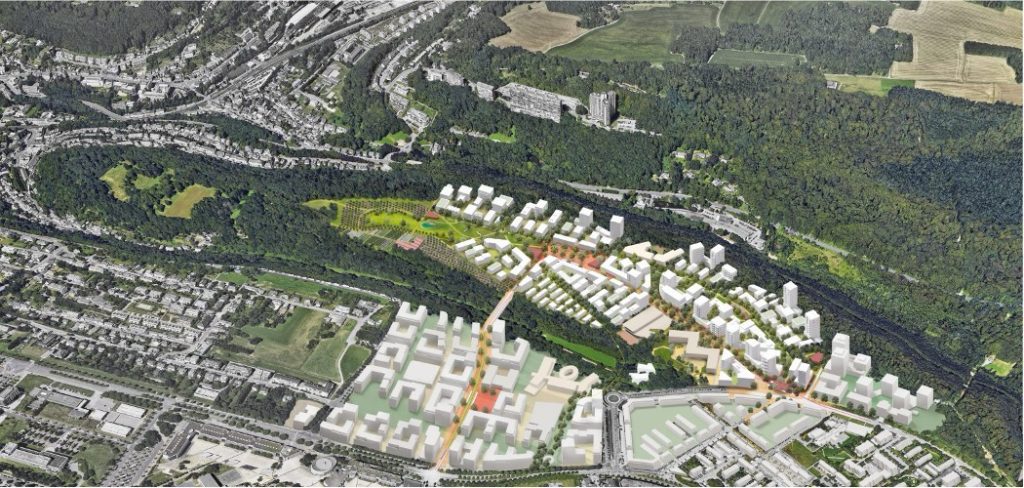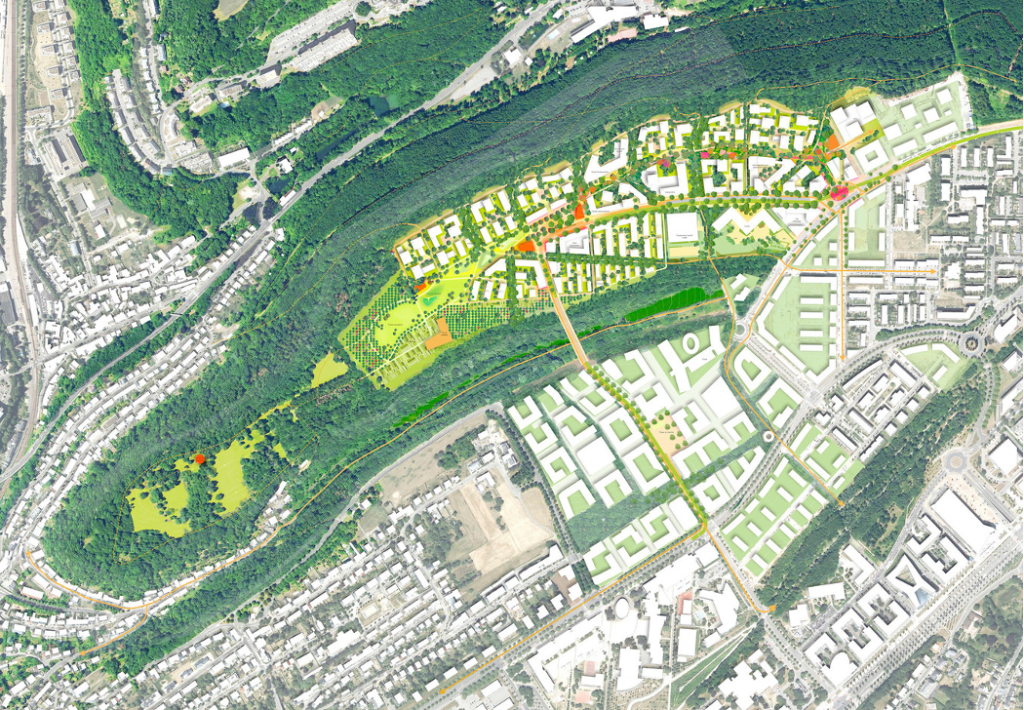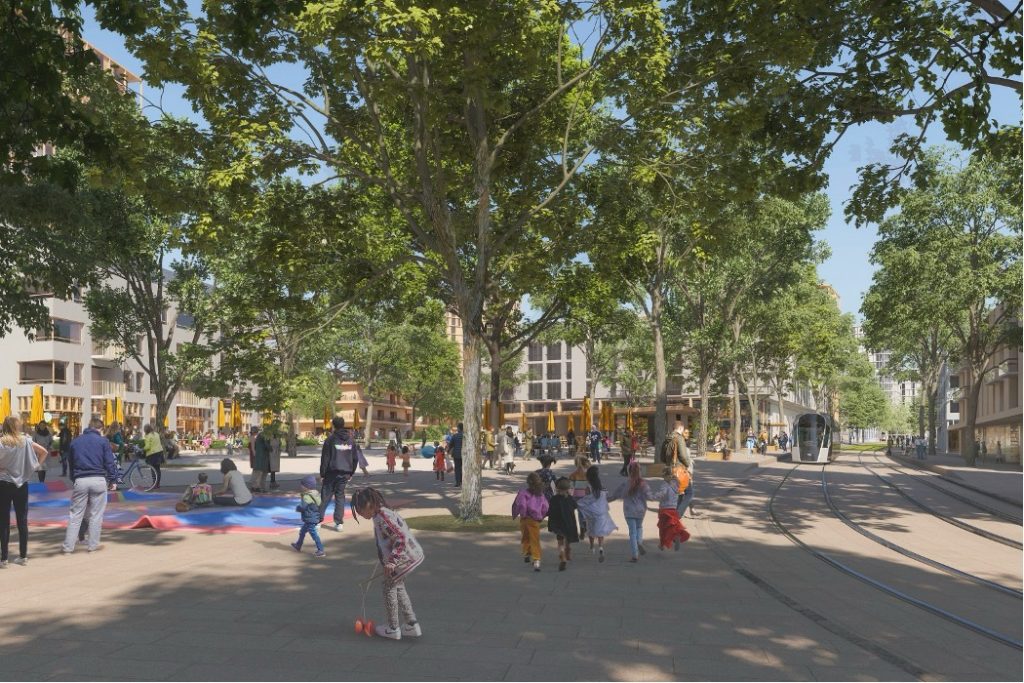Introducing Kuebebierg, a new urban development in Luxembourg’s Kirchberg area managed by the Fonds Kirchberg, focused on creating a sustainable and inclusive community. With an emphasis on environmental responsibility, social diversity, and economic viability, Kuebebierg aims to set a benchmark for future urban projects. From promoting alternative transportation to supporting local agriculture, Kuebebierg offers a balanced approach to urban living that prioritizes harmony with nature.
Aim
The aim of the Kuebebierg project is to create a vibrant, environmentally conscious neighbourhood that promotes sustainable living, social inclusivity, and economic vitality. Through careful planning and implementation, the project seeks to establish Kuebebierg as a model for future urban developments, both locally and internationally.

The Kirchberg quarter located on the north-eastern plateau of Luxembourg city is the vibrant business district, hosting not only banking and financial organisations but also EU institutions. The Fonds Kirchberg, established in 1961, operates under the supervision of the Minister of Mobility and Public Works and is responsible for urbanisation and development of the Kirchberg Plateau. It manages its operations and investments independently, relying on proceeds from real estate activities. Its main tasks include construction, urban development, and road infrastructure, with a current focus on building affordable housing. The Fund utilizes leasehold and other rights for land development, emphasising sustainability and community involvement in its planning processes.
The Fonds Kirchberg launched a competitive consultation process to develop an urban design charter establishing objectives for the landscape of the Kuebebierg area, a major land reserve belonging to the public organisation. The 33-ha area is located in a so-called deferred development zone (zone d’aménagement différée, or ZAD). The winning team of the consultation process presented its project in March 2022. The consortium is led by the Güller Güller Architecture Urbanism office in Rotterdam and Zurich, cooperating with Zeyen+Baumann, Atelier Alfred Peter, Etienne Ballan, Cabane Partner, RR&A, ZEFCO, Ecolor, Ville en Œuvre and Belvédère.

Activities
With its circular design and ecological focus, Kuebebierg aims to create a vibrant, liveable community that integrates seamlessly with its surroundings. Activities within the neighbourhood are guided by a holistic vision that embraces the area’s natural and urban characteristics, prioritising principles of sustainability and community well-being.
- Promoting Active Mobility: Kuebebierg prioritises diverse mobility options to reduce reliance on individual cars. Direct and secure routes for pedestrians and cyclists are integrated, along with the commissioning of a new tram line to enhance public transport accessibility.
- Limiting Car Circulation: With only one vehicle access point and a ratio of 0.5 cars per dwelling, Kuebebierg encourages a shift away from car-centric urban planning. Shared spaces accommodate various modes of transportation, fostering a safer and more vibrant urban environment.
- Creating Vibrant Public Spaces: The heart of Kuebebierg features a bustling square, reminiscent of traditional city centres, offering a diverse mix of shops, restaurants, and recreational amenities. These vibrant public spaces serve as focal points for social interaction and community engagement. A linear park and the tram line will connect public spaces, crossed by the spaces “Porte Frieden” and the “Place du Kuebebierg”.
- Maximising Renewable Energy Production: Kuebebierg embraces energy efficiency by prioritising renewable energy sources. From efficient building design to on-site energy production and storage, the district aims to minimise its carbon footprint while ensuring optimal living conditions for residents.
- Fostering Social Diversity: With a balanced mix of housing typologies and amenities, Kuebebierg promotes social inclusivity and diversity. Affordable housing options, coupled with accessible public services and recreational facilities, create an environment where people from all walks of life can thrive.
- Living circularity: the planned programme for the site, the architecture and the infrastructures are all aiming for a high standard regarding carbon footprint, local consumption and low energy demands, etc. In this context, the concept includes for example an urban farm and gardening.
- Farming in the City: The city farm project aims to maintain agricultural activity on one of the last remaining sites on the Kirchberg Plateau worked by farmers. It promotes biodiversity through more extensive green space management and offers multifunctional farming activities, including grazing, market gardening, and agro-tourism, contributing to economic, environmental, and socio-cultural services within the community.

Status of Implementation
The implementation of the project started in 2022. At the western tip of the district, where the city farm and orchards are also planned, initial work began at the end of 2023 (planting trees and exploratory drilling for geothermal energy). This part of the district will also be included in the exhibition LUGA – Luxembourg Urban Garden taking place in 2025.

Outlook
The winning project for Kuebebierg embodies a vision of urban living in harmony with nature. By integrating topography and green spaces, creating pedestrian-friendly environments, and prioritising sustainability, Kuebebierg sets a new standard for future urban developments.
As construction progresses, Kuebebierg aims to become a living testament to the possibilities of sustainable urban planning. The aim is to achieve a district development plan for 2025, build infrastructure in 2027 and initiate the construction of housing in 2029. With its innovative approach and commitment to environmental and social well-being, Kuebebierg represents not just a neighbourhood but a vision of a more sustainable, inclusive, and resilient urban future.
Contact
Fonds Kirchberg: info@fondskirchberg.lu
References
Fonds Kirchberg (French): https://fondskirchberg.public.lu/fr/concepts-urbains/quartiers-futur/kuebebierg.html
Communication of the Luxembourgish government (French): https://gouvernement.lu/fr/actualites/toutes_actualites/communiques/2022/03-mars/02-urbanisation-terrains-kuebebierg.html
Paperjam article (French): https://paperjam.lu/article/kuebebierg-quartier-tourne-ver Record of the project presentation (French): https://www.youtube.com/watch?v=G56wT-yC8mw&t=38s

